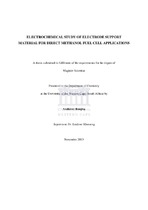| dc.contributor.advisor | Khotseng, L. | |
| dc.contributor.author | Bangisa, Andisiwe | |
| dc.date.accessioned | 2014-06-12T07:56:33Z | |
| dc.date.available | 2014-06-12T07:56:33Z | |
| dc.date.issued | 2013 | |
| dc.identifier.uri | http://hdl.handle.net/11394/3319 | |
| dc.description | >Magister Scientiae - MSc | en_US |
| dc.description.abstract | This study focused on binary PtRu and PtSn electrocatalyst, synthesized using the polyol
approach and supported on MWCNTs, TiO2 and MoO2 materials, after synthesis part of the resultant electrocatalyst was heat treated to improve alloying of the secondary metal to the primary platinum metal catalyst and also to enhance the stable distribution and uniform dispersion of the nanoparticles on the support material. Physical characterization of the supported catalyst was done using XRD, HRTEM, HRSEM and EDS for elemental analysis. For electrochemical characterization RDE-CV and RDE-LSV were employed. The homeprepared electro-catalysts were then compared to the Pt/C, PtRu/C and PtSn/C commercial electro-catalysts accordingly. XRD confirmed that the binary electro-catalyst for both the commercial and home-prepared display characteristic patterns similar to that of the standard Pt/C electro-catalyst, an
indication that all catalysts have prevailed the Pt face-centred-cubic (fcc) crystal structure. Particle size and size distribution examined using HRTEM showed that Pt/C and PtSn/C was uniformly dispersed on the carbon support and that all electrocatalyst supported on MWCNTs showed small particle size known to enhance the activity of the catalyst. However, after heattreatment the particle size increased for all prepared supported electrocatalyst as was expected from literature. SEM micrographs showed that all electrocatalyst were decorated on the support material with agglomerates on some parts of the samples, agglomeration was more pronounced for catalysts supported on MoO2. The metal loading for the home- prepared electrocatalyst was examined using EDS and it was observed to be closer to that of the commercial catalysts. It was also observed that there were changes on the loading of the
electrocatalysts after they were subjected to heat treatment and depending on the support material the metal loading of the catalyst was either more or less.
This study found PtSn/C to be the most active commercial catalyst for methanol tolerant and oxygen reduction. For the home-prepared electrocatalyst supported on MWCNTs, PtSn/MWCNT-HT was found to be the most active catalyst while for catalyst supported on metal oxides PtSn/MoO2 was found to be more active than the rest of the Pt-based electro catalyst supported on metal oxides. Results showed that PtSn is more active than PtRu and could function as a methanol tolerant oxygen reduction electro-catalyst for the cathode of a direct methanol fuel cell. Furthermore, in terms of durability, the home-prepared electrocatalyst proved to be more durable than the commercial electro-catalyst supported on carbon black, with catalyst supported on MWCNTs showing more stability than other supported electro-catalyst. Multi-walled carbon nanotubes have therefore proven in this study to be the best supporting material for electro-catalyst as catalyst supported on them showed to be more stable than commercial catalyst supported on carbon black. | en_US |
| dc.language.iso | en | en_US |
| dc.publisher | University of Western Cape | en_US |
| dc.subject | Electrode support material | en_US |
| dc.subject | Methanol fuel cell applications | en_US |
| dc.subject | PtRu and PtSn electrocatalyst | en_US |
| dc.title | Electrochemical study of electrode support material for direct methanol fuel cell applications | en_US |
| dc.type | Thesis | en_US |
| dc.rights.holder | University of Western Cape | en_US |

